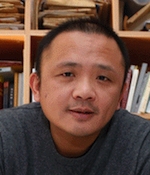-
1996-
1999, 中国科学院物理所 , 博士
-
1993-
1996, 浙江大学 , 硕士
-
1989-
1993, 浙江大学 , 学士
-
2017-至今, 香港科技大学, 教授
-
2007-2017, 中国科学院物理所, 教授
-
2004-2007, 香港大学, 助理教授
-
2002-2004, 罗格斯大学, 博士后
-
2001-2002, 波士顿学院, 博士后
-
1999-2001, 香港科技大学, 博士后
-
开发强相关材料电子结构的计算方法
-
寻找现实材料中的拓扑非三维量子态
-
Yuanfeng Xu, Changming Yue, Hongming Weng and Xi Dai, “Heavy Weyl Fermion state in CeRu4Sn6”, Phys. Rev. X7, 011027 (2017).
-
Alexey A. Soluyanov, Dominik Gresch, Zhijun Wang, QuanSheng Wu, Matthias Troyer, Xi Dai and B. Andrei Bernevig, “A New Type of Weyl Semimetals”, Nature 527 , 495-498, (2015).
-
Hongming Weng, Chen Fang, Zhong Fang, B. Andrei Bernevig, and Xi Dai,”Weyl Semimetal Phase in Noncentrosymmetric Transition-Metal Monophosphides”, Phys. Rev. X 5, 011029 (2015)
-
H. Weng, J. Zhao, Z. Wang, Z. Fang and Xi Dai , "Topological Crystalline Kondo Insulator in Mixed Valence Ytterbium Borides." Physical Review Letters 112, 016403 (2014).
-
Z. Wang, Y. Sun, X.-Q. Chen, C. Franchini, G. Xu, H. Weng, X. Dai and Z. Fang, “Dirac semimetal and topological phase transitions in A3Bi (A=Na, K, Rb)”, Physical Review B 85, 195320 (2012).
-
Feng Lu, JianZhou Zhao, Hongming Weng, Zhong Fang, and Xi Dai,“Correlated Topological Insulators with Mixed Valence”, Phys. Rew. Lett. 110, 096401 (2013)
-
Rui Yu, Wei Zhang, Hai-Jun Zhang, Shou-Cheng Zhang, Xi Dai and Zhong Fang, “Quantized Anomalous Hall Effect in Magnetic Topological Insulators”, Science 329, 61, (2010).
-
H. Zhang, C.-X.Liu, X.-L. Qi, X. Dai, Z. Fang, and S.-C. Zhang,“Topological insulators in Bi2Se3, Bi2Te3 and Sb2Te3 with a single Dirac cone on the surface”, Nature Phys. 5, 438, (2009).
-
X. Deng, L. Wang, X. Dai, and Z. Fang,"Local density approximation combined with Gutzwiller method for correlated electron systems: Formalism and applications", Physical Review B 79, 075114 (2009).
-
X. Dai, S. Y. Savrasov, G. Kotliar, A. Miglori, H. Ledbetter and E. Abrahams, "Calculated phonon spectra of plutonium at high temperatures”, Science 300, 953 (2003).

